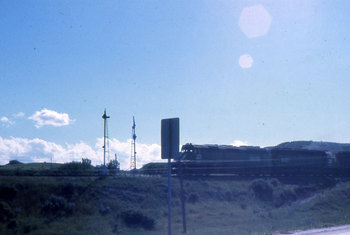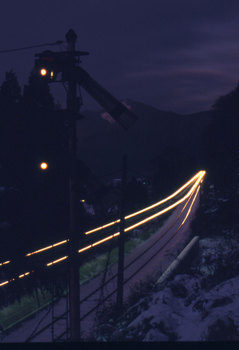Fail-Safe design 01 [Column_Tracksides]
 : somewhere in MT, summer, 1971
: somewhere in MT, summer, 1971I don't know well about the technical design. But I can understand that the semaphore has the form came from the theory of fail-safe. The "RED" signal has more stability than that of the "GREEN" signal. It's same here in Japan.
The difference is that the "GREEN" signal for BN freight led by EMD F45 6628 is in upright position, contrary to the "GREEN" signal for the JR express "SAKYU" is in downward. I think that it's a kind of difference that you "push" the saw, while we the Japanese "pull" the saw.
But I think that the upright position is more suitable for the "GREEN" than the downward position. The upright position brings me the atmosphere of "Here we go".
車中からとっさに撮った写真だが、腕木式信号機が写っている。写真右(奥)側の信号機がEMD製F45が牽く貨物列車に「進行」を現示しているのが分かるだろうか。
北米の腕木式信号機では腕がほぼ垂直に上がっている状態が「進行」である。一方、日本では下に下がっている状態が「進行」である。どちらも、なんらかの不具合があった場合「停止」を示すよう、"fail safe"の思想に基づいて設計されているはずである。両者の違いはどこからくるのだろう。筆者は技術的な知見にうといので、のこぎりの「押す」と「引く」の違いのようなものかと思っている。
ただ、腕が上がっている方が、"Here we go"という感じがするのはわたしだけだろうか。
北米の列車無線を聞けるHP;
 : Mimasaka-Kawai Okayama Pref. Japan, Dec. 17, 1994
: Mimasaka-Kawai Okayama Pref. Japan, Dec. 17, 19942010-02-26 11:30
コメント(2)
トラックバック(0)




またまた凄い写真ですね。実は、かつて日本にも上向きがあったのです。当方の次の号をご覧ください。
http://works-k.cocolog-nifty.com/page1/2006/10/y_7e7c.html
by ワークスK (2010-02-26 21:24)
元画像を拡大してみました。レンズがはまっている扇形のプレートの大きさ・形から2位であるようです。
また、別記事に書きましたが、彼の地でも上・下色々あるようです。
by arx (2010-03-01 12:57)